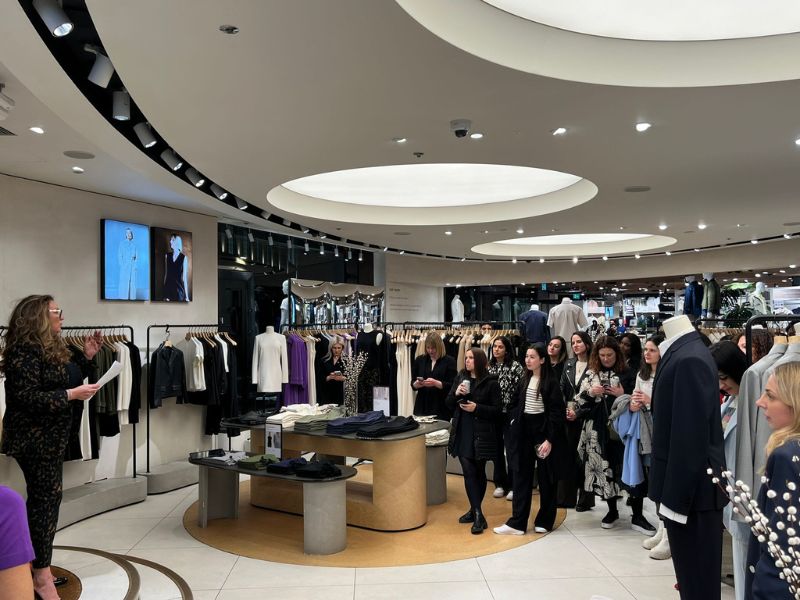As with so many recent developments in fashion, this explosion of interest on the part of our menfolk has been fuelled by the internet. There now exists a preponderance of menswear blogs, sating a voracious appetite for knowledge of topics from the latest in street style to the minutiae of tailoring, and allowing men to out themselves as dedicated followers of fashion.
“I’ve been photographing style on the street since 2007, and the change has been remarkable,” claims Jonathan Daniel Pryce, a fashion photographer who runs the style blog Another Garçon, and whose book, 100 Beards 100 Days – documenting the facial hair of Londoners – was published last year. “British men have noticeably smartened up, taking a more considered approach to dressing. Only a few years ago the high street was full of men in badly fitting jeans and comical graphic T-shirts. Now the average British man is far more knowledgeable about designers, fabric and cut when I chat to them on the street. They take pride in dressing intelligently.”
Bill Cunningham, the pioneer of street-fashion photography, who has borne witness to every style revolution since the 1960s, believes that men’s fashion is freer now than it has ever been. Talking recently about the people he photographed at Paris Fashion Week for the New York Times, he linked this to the acceptance of gay marriage and the freedom men are experiencing because of it: “Young men are just finally opening the door and wearing what they want,” he said. “This whole antiquated idea of good and bad taste – there is no such thing.”
Menswear has long had a tribal aspect, linked inexorably with music – only these days, men have stepped out of the long shadows cast by their idols, be they indie, rock, hip-hop or punk. “The worst thing in the world is the ageing rocker,” says Alex Bilmes, editor of Esquire, which earlier this month launched The Big Black Book, a biannual style spin-off. “There’s a social shift towards this supermarket of style, where you can pick and choose from the best bits of everything and there’s no need to be tribal.
“I think men were embarrassed before – there was a blokeishness that said it wasn’t the done thing to show an interest in fashion; it was seen as effeminate. Men were interested in sport and war; girls were interested in fashion.” But, nearly 20 years after the term metrosexual was coined, such binary ideas are now outdated. “We’re allowed to share interests,” agrees Bilmes. “Girls are allowed to watch football, men can shop in Burberry.”
It is telling that this is the name Bilmes chooses to drop. Not only was menswear the fastest-growing category for Burberry in the first half of the 2012/13 financial year – with tailoring growing by more than 50 per cent and men’s accessories by nearly 40 per cent in the last quarter of 2012 – but the British brand recently announced that it will be moving its menswear show to London after more than 10 years of launching its ranges in Milan. This will add considerable prestige to the nascent London Collections: Men, a three-day fashion extravaganza inaugurated last June, which finally gave the capital a menswear event to compare with those held across Europe.
The decision to roll out London Collections proved to the world not only that Britain recognises the value of men’s fashion, but also that it is proud of its rich heritage in the sector, from the tailoring traditions of Savile Row to the anti-establishment creativity of sub-cultures from mods to rockers to punks. It is a particularly timely launch given that, according to Global Industry Guide, the total global menswear market is forecast to have a value of more than £268bn by 2016, an increase of 13.9 per cent since 2011; the British Fashion Council’s Future of Fashion Report 2012, meanwhile, states that men’s items now represent 50 per cent of the luxury apparel market.
While London’s world-renowned fashion courses should ensure there will be a continual flood of young talent to the industry, designers who have made their name in womenswear are also increasingly branching out into menswear, from Christopher Kane and Jonathan Saunders to Richard Nicoll.
“Men have always been interested in style, but fashion hasn’t always been fashionable for men,” says Nicoll. “Now I think it’s more acceptable to be interested in fashion – perhaps it’s becoming less elitist and more widely appealing. When London Collections: Men was announced it seemed like the perfect moment to launch our men’s line, and I was reassured by the response; it shows that men are as fashion-conscious as women, are equally open to new brands and have a hunger for unique newness.”
As well as those just starting in menswear, the London collections held in January attracted big names such as Alexander McQueen, Tom Ford and Vivienne Westwood. “In the same way that British men have been reluctant to express an interest in fashion, I think the British menswear industry as a whole has not waved its flag high enough – but now it is,” says Bilmes of the overdue event. “It does encourage men to get into fashion.”
One brand that understands the value of well-known, stylish men is Mr Porter, the luxury e-tailer which, since launching in February 2011, has associated itself with male stars of sports, music, film and fashion through its editorial-led content. “More and more men care about their own style and looking good in general,” says Toby Bateman, buying director of the site. “It no longer holds the stigma that it used to for the ‘regular bloke’. It wasn’t long ago that being into fashion or wearing something a bit ‘trendy’ would have caused derision from a group of friends or colleagues; now it’s something to be proud of.”
Mr Porter has tapped into that pride – and the peacockish tendencies of certain men – with an Instagram-linked competition which asks customers to upload a picture of themselves at their most stylish. In its first month alone the microsite received more than 85,000 visitors, and nearly 4,000 pictures were submitted.
“Men’s style has grown massively in the past five years,” says Bateman. “That growth has been driven by the accessibility of fashion through magazines, blogs and celebrity influence, as well as designers who have focused on reinterpreting classic menswear, giving men’s fashion a broader and more masculine appeal. Young men now share more of the values of their grandfathers than their fathers when it comes to dressing – a well-cut suit, a well-made shoe, knowing how to knot their tie according to the shape of collar.”
One factor responsible for the renaissance of this dandyish attention to detail can be attributed at least in part to the success of Mad Men, starting in 2007. The suave male characters and meticulous period detail of the show sparked a surge not only in slimline tailoring but also pocket squares, collar pins and retro accessories.
Whether their sartorial influences come from the street, the catwalk or popular culture, it seems that men are happy exploring their personal style within a framework of rules: “Men are increasingly interested in fashion,” says Bilmes, “but the way that one talks to them about it is slightly different from the way that one talks to women. Men don’t mind being told [what looks good on them and what doesn’t]; they’re not precious about it. They think, ‘OK, I’m interested in it, I want to look good. I don’t want to look stupid and I don’t want to look like a fashion victim.'”








